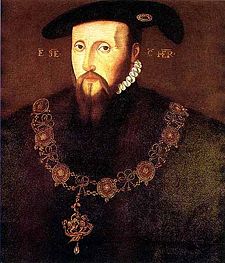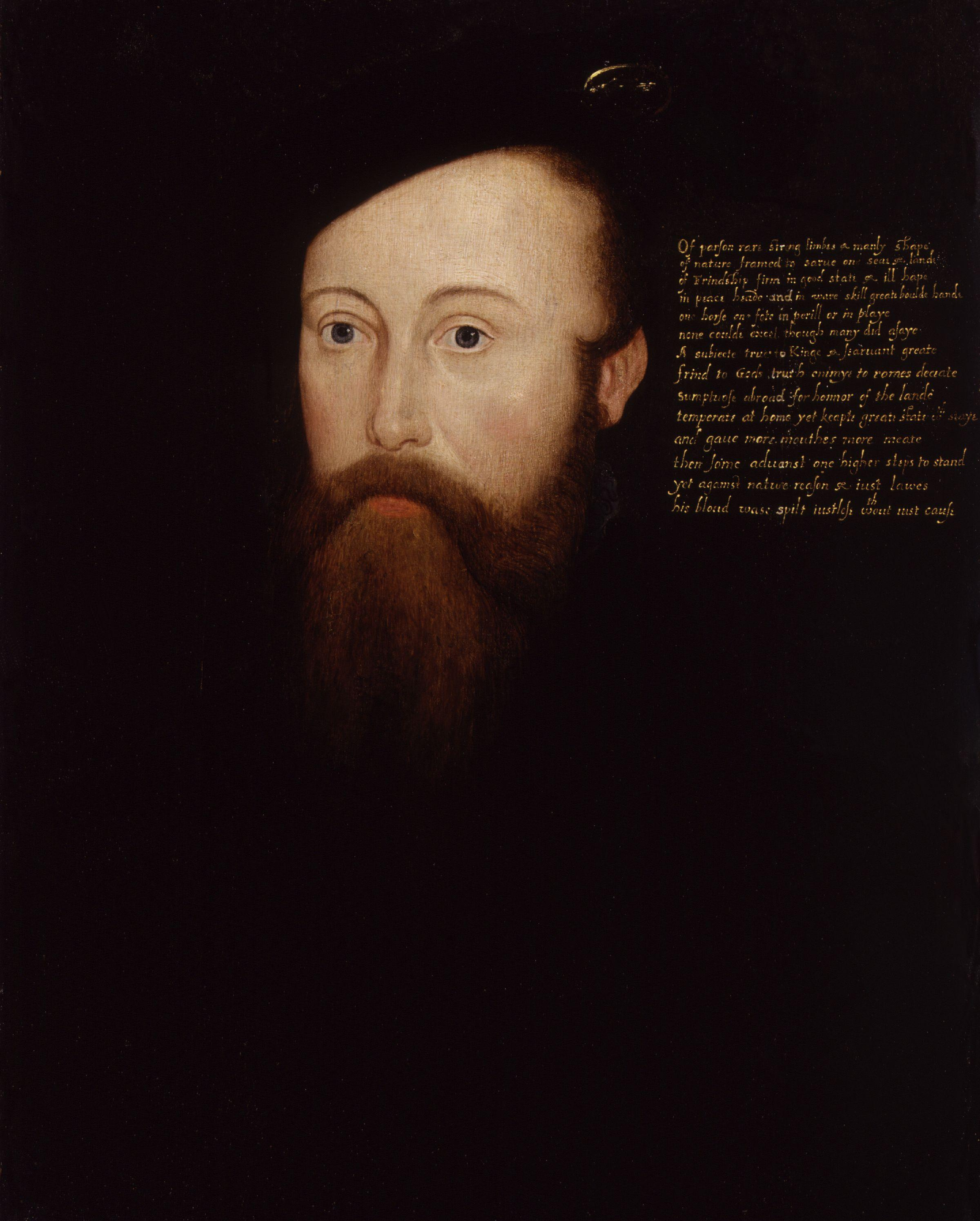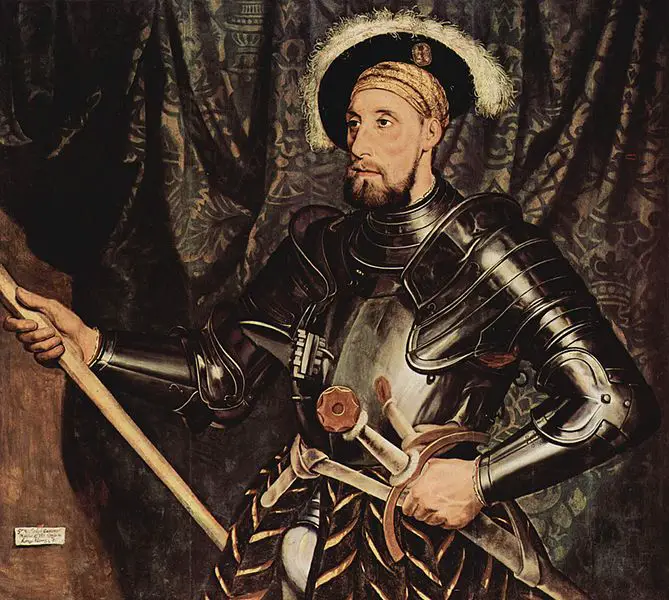 The fifth article in Sarah Bryson's series on prominent Tudor courtiers...
The fifth article in Sarah Bryson's series on prominent Tudor courtiers...
Edward Seymour, Duke of Somerset is one of the most well-known of Henry VIII's courtiers. Although the duke was most influential under the reign of his nephew, King Edward VI, it was during the reign of Henry VIII that Seymour started his ascent at the Tudor court.
The exact date of Edward’s birth has not been recorded, but it is believed that he was born around 1500 at the family’s home of Wolf Hall, Wiltshire, to Sir John Seymour and Margery Wentworth. John and Margery had ten children: six sons (John, Edward, Henry, Thomas, John and Anthony) and four daughters (Jane, Elizabeth, Margery and Dorothy). Edward Seymour was descended from the ancient family lines of the Percys and Cliffords, and his father served both King Henry VII and King Henry VIII as Sheriff of Wiltshire and Sheriff of Somerset and Dorset, cementing the family’s loyalty to the Tudors.
Edward Seymour was introduced to court by his father in 1514 at the age of approximately fourteen years. In 1514 he was appointed as a page to Mary Tudor, younger sister of Henry VIII, when she travelled to France to marry King Louis XII. In October, after the wedding, Louis XII dismissed many of Mary’s servants retaining only a small number, including young Edward.
On 15th July 1517, Edward and his father were appointed joint constables of Bristol Castle and the surrounding lands. On 25th August 1521, the secret Treaty of Bruges was signed between Charles V and Thomas Wolsey on behalf of Henry VIII declaring that Henry would support Charles V in the war against France. In May 1523 England officially declared war upon France and Edward travelled to France under the service of Charles Brandon, Duke of Suffolk, and participated in the capture of Bray, Roye, and Montdidier. He was knighted by Brandon at Roye on 1st November 1523.
Seymour’s star continued to rise, and in 1524 he was created an esquire of the king’s household. On 12th January 1525, he was elected as a Justice of the Peace for Wiltshire, as well as being created the Master of the Horse for Henry Fitzroy, Duke of Richmond, the illegitimate son of King Henry VIII. Seymour gained his first taste of ambassadorial duties in July 1527 when he accompanied Cardinal Thomas Wolsey to France when the cardinal began secret discussions regarding Henry VIII’s “Great Matter” – a possible annulment of his marriage to Queen Katherine of Aragon.
On 5th March 1529, Seymour was made a steward of the manors of Henstridge in Somerset and Charlton in Wiltshire. Two and a half years later, on 12th September 1531, Seymour was appointed an esquire of the body to Henry VIII with an annuity of 50 marks. On New Year’s Day 1532, Seymour presented the king with a gift of a sword with a gilt handle, and in return, Henry VIII gave Edward money, a sign that the king favoured Edward.
Towards the end of 1532, Seymour was riding high in the king’s favour, and he accompanied Henry VIII and Anne Boleyn to Calais where they met with King Francis I of France. At Anne Boleyn’s coronation banquet on 1st June 1533, Seymour had the honour of acting as a server to the Archbishop of Canterbury.
In October 1535, Seymour had the great honour of having the king and queen visit him and his family at his manor of Elvetham in Hampshire. Less than six months later, on 3rd March 1536, Seymour was invested as a gentleman of the privy chamber. This position put Edward in close proximity to the King and provided him with regular opportunities to converse with Henry VIII. Shortly after this, Edward, his wife Anne and his sister Jane were given rooms at the Palace of Greenwich.
There has been much written about Edward’s sister, Jane, and her courtship with King Henry VIII. Far too much to detail in his small biography of Edward. It has been proposed that Edward coached his sister to turn Henry VIII away from his second wife, Anne Boleyn. Others have suggested that Jane was coached by Sir Nicholas Carew, a distant relative of the king. Whether Jane was coached, or if she acted on her own, she married Henry VIII on 30th May 1536 in the Queen’s Closet at Whitehall. Seymour was now brother-in-law to the king.
On 5th June 1536, Seymour was created Viscount Beauchamp of Hache with an annuity of 20 marks and a grant of lands and manors in Wiltshire. The following year, on 22nd May, Seymour was admitted into the Privy Council and also to Parliament where his new title ranked him higher than the barons.
Seymour was quick to cement his new position, and on 7th July, he purchased the position of Captain and Governor of Jersey for £150. In the August he was appointed as Chancellor of North Wales.
On 12th October 1537, at two o’clock in the morning, Queen Jane Seymour gave birth to a baby boy named Edward. Seymour was now uncle to the future king. On 15th October, a grand procession took place at Hampton Court taking the newly born prince to the Chapel Royal where he was christened. Seymour had the honour of carrying little Elizabeth, Henry VIII’s daughter, during the coronation procession. Three days later, on the 18th, he was created Earl of Hertford with an annuity of £20. Tragically, Jane died just twelve days after the birth of her son of what was most likely puerperal fever, an infection of the vaginal passage or womb.
After his sister’s death, Seymour’s rise stalled briefly, yet, he continued to hold the king’s favour. In March 1538, his son and heir, Edward, was born and the king and Thomas Cromwell stood as godfathers to the infant. In August of the following year, the king sent Seymour to defend Calais and Guines against the French, and he was granted the distinct honour of meeting Anne of Cleves, the woman who would become Henry VIII’s fourth wife, at Calais and escorting her to England.
After a period of relative inactivity, Seymour’s star rose once more during the final years of Henry VIII’s life. He was elected to the Order of the Garter on 9th January 1541 and was included in a small council to govern the affairs in London while the king went on his northern progress between July and November. In September 1542, Seymour was appointed to the position of Warden of the Scottish Marches, although he spent only a few weeks there before returning to London. On 28th December 1542, he was created Lord High Admiral and then on 16th February 1543 he was created Lord Great Chamberlain, one of the highest positions at court.
In December 1543, Scotland broke ties with England, and Seymour was appointed as Lieutenant General in the North. He left for the border in March 1544 and began a series of skirmishes against Scotland and an attempted invasion of Edinburgh. In June, England went to war with France. While Henry VIII was overseas, his sixth wife, Katherine Parr, was appointed regent. Seymour was instructed to act as one of the queen’s councillors. One of Seymour’s first duties was to dismiss the women of Edward Tudor’s household and install him with a male dominated household, including the addition of his own son Edward.
Seymour’s time as councillor under Queen Katherine was short-lived as on 13th August 1544 he travelled to France to serve in the king’s army. He was present at the capture of Boulogne on 14th September and took command of the city when the French made an attempt to recapture it.
Upon returning to England, Seymour was again appointed as Lieutenant General of the North in May 1545 and instructed to organise an invasion of Scotland. Once more he conducted a series of skirmishes and battles along the Scottish border which came to be known as ‘rough wooing’. Leaving Scotland in October, Seymour returned to Parliament until he was ordered to leave for Boulogne in March 1546.
Seymour was influential in negotiating a treaty with France which would see England occupy Boulogne until 1554 when the French would buy it back. In the final years of Henry VIII’s reign, Seymour travelled between France and England. He witnessed the fall of Thomas Howard, 3rd Duke of Norfolk, and his son Henry Howard, Earl of Surrey. Seymour and Howard had fallen out several years previously and with Howard’s fall from grace Seymour’s position rose.
By the end of 1546, Henry VIII was seriously ill and not likely to live long. On 26th December, the king drew up his will, appointing sixteen men to be the executors of his will and councillors to his son, the future Edward VI; one of these men was Edward Seymour.
Henry VIII died on 28th January 1547; his son Edward was just nine years of age. The late king’s death was kept secret for several days, and it was during this time that Seymour put a plan into action. With the support of Sir William Paget, Seymour sought to become the ‘Lord Protector’ of the king and the head of the council that would rule England until Edward VI came of age.
On 1st February 1547, Seymour was officially created Lord Protector of the Realm and Governor of the King’s Person. He also acted as High Steward of England for Edward VI’s coronation and held the positions of Lord Treasurer and Earl Marshal. Then, on 17th February, he was created Duke of Somerset. Seymour was now the most powerful man in England, a king in all but name.
He sought religious reform, rejected the idea of debasing the coinage to counter price inflation, and brought about the Treasons Act which stated that two people must witness an act of treason rather than just one. He also sought to increase grain production and reduce sheep grazing by enforcing enclosures. This was met with great resistance as the people relied upon the common ground to let their sheep graze. In a period of approximately two years, Seymour also allowed around £20,000 of the crown's annual income to be granted to members of the court in the form of gifts and entitlements.
There were soon those at court that resented Seymour’s power, including his brother Thomas. Thomas Seymour acted irrationally, marrying the Dowager Queen Katherine Parr without the young king’s permission and possibly behaving inappropriately towards the young Princess Elizabeth. He spoke out against his brother, and in a desperate attempt to obtain the king’s ear he even made an attempt to kidnap Edward VI! Ultimately, Thomas was arrested, and Seymour agreed to have his brother executed. This act greatly harmed Seymour’s reputation.
War with Scotland always loomed on the horizon and in 1547 Seymour personally led about 19,000 men north. Seymour and his men won a decisive victory at Pinkie, located nine miles east of Edinburgh, on 10th December. France quickly came to Scotland’s aid, and in June 1548 the French army landed at Leith, attacking various posts held by the English. As this was happening England’s defences of Calais and Boulogne were attacked. In a desperate effort to defend their cities in England Seymour was forced to hire mercenaries to fight on England’s behalf. The huge costs were disastrous for England and saw the crown debasing the coinage, selling off crown lands and seeking large loans. For such great expenses, the results were little, with English forces withdrawing from many garrisons surrounding Boulogne. Ultimately, the great cost of defending Boulogne saw its return to France in 1550.
Meanwhile, in early 1548, rebellion broke out in Cornwall and spread to Devon and Somerset. People protested against the Book of Common Prayer and other religious changes that had been put in place when Edward VI came to the throne. Instead of responding to the rebellion straight away, Seymour seemed to delay, and it was not until August that the rebellions were finally stopped.
Only a year later in July 1549, another rebellion broke out in East Anglia. This time, the common people protested against landlords who enclosed land and misused their power. The leader of this rebellion was Robert Kett, a tanner from Wymondham. The rebels managed to occupy Norwich, the second largest city in England at the time. Instead of raising an army against the rebels, Seymour wrote some letters, sympathising with them and offering pardons, even promising to bring up their grievances in Parliament. Members of the king’s council were furious at such indecisive action, and it was not until John Dudley, Earl of Warwick, led an army against the rebels that they were finally stopped on 27th August.
With the series of rebellions, as well as the great financial costs of war against Scotland and France, many of those on the council had lost faith in Seymour. Seeking support, Seymour sent out letters requesting men take up arms and head to Hampton Court to defend the king. Seymour then took Edward VI to Windsor Castle to better defend him. Seymour was no fool, and with the majority of the council against him, he finally surrendered himself on 11th October 1549. He was sent to the Tower of London the following day, and on 14th January 1550 Parliament officially dissolved him of his title and deprived him of his positions at court, his land and grants worth around £2000 a year.
Edward VI stated that his uncle’s crimes were: “ambition, vainglory, entering into rash wars in mine youth, negligent looking on Newhaven, enriching himself of my treasure, following his own opinion, and doing all by his own authority.”
John Dudley, Earl of Warwick, tightened his grip on the council and began to oversee the running of England. Seymour was released from the Tower on 6th February 1551 and received a pardon on the 8th. However, he was still under house arrest. Finally, on 8th April, Seymour was admitted back into the council. He was restored as a gentleman of the king's chamber on 14th May, and on the 17th his lands were returned to him. Seymour was then made Lord Lieutenant of Berkshire and Hampshire on 10th May 1551.
Soon rumours began to spread that Seymour sought to regain his former power. Sir Thomas Palmer alleged that Seymour was planning to invite Dudley and the Marquess of Northampton to dinner, kill them, take control of the Tower of London and have the people of London rise in rebellion. Although it was doubtful that there was any truth to such rumours, John Dudley, now the Duke of Northumberland, was not going to take any chances. After a dinner with Edward VI on 16th October 1551, Seymour was arrested and taken to the Tower of London.
On 1st December 1551, Seymour was tried by his peers. He pleaded “not guilty”. He defended himself skilfully and was acquitted of treason but found guilty of bringing men together to riot against the king. Seymour’s execution was set for 20th January 1552. Such was the concern that there would be rioting, people were ordered to stay in their homes, and a thousand guards attended the execution.
At eight o’clock on the morning of 20th January 1552, Seymour was beheaded on Tower Hill. Before his death, he denied that he had ever offended the king but that he was condemned to death by the law. He was buried in the Chapel of St Peter ad Vincula within the Tower of London, between the graves of Anne Boleyn and Catherine Howard.
Edward Seymour had been a controversial figure throughout his life. He started his life at court under the rule of King Henry VIII, and his favour grew with the marriage of his sister to the king. Seymour was politically astute and had a strong understanding of military tactics. However, he appeared to have been a man who overreached himself and was unable to retain his grasp upon ultimate power.
Sarah's other "The King's Men" articles:
- The King's Men - Nicholas Carew
- The King's Men - Thomas Brandon
- The King's Men - William Carey
- The King's Men - Edward Stafford
Sources
- Bernard, G.W. 2015, Seymour, Thomas, Baron Seymour of Sudeley (b. in or before 1509, d. 1549), Oxford Dictionary of National Biography, Oxford University Press, viewed 19 February 2017, http://www.oxforddnb.com/view/article/25181.
Beer, B 2009, Seymour, Edward, duke of Somerset (c.1500–1552), Oxford Dictionary of National Biography, Oxford University Press, viewed 18 February 2017, http://www.oxforddnb.com/view/article/25159.
- "Britain's Tudor Treasure: A Night at Hampton Court" (2015) Documentary, BBC, United Kingdom, Presented by Dr Lucy Worsley and Dr David Starkey.
- Letters and Papers, Foreign and Domestic, of the Reign of Henry VIII, 1509-47, ed. J.S Brewer, James Gairdner and R.H Brodie, His Majesty's Stationery Office, 1862-1932.
- Lipscomb, S (2015) The King is Dead: The Last Will and Testament of Henry VIII, Head of Zeus, London.
- Richardson, Douglas (2011) Plantagenet Ancestry: A Study In Colonial And Medieval Families, 2nd Edition, CreateSpace, USA.
- Scard, M (2016) Edward Seymour: Lord Protector Tudor King In All But Name, The History Press, Gloucestershire.
- Skidmore, C (2011) Edward VI The Lost King Of England, Orion Books, London.
- Wilson, Derek (2009) A Brief History of Henry VIII, Constable and Robinson Ltd., London.





What a great summary of Edward Seymour’s life! Very interesting to read about the main points of his life in the broader context of all of the other events going on during those times…